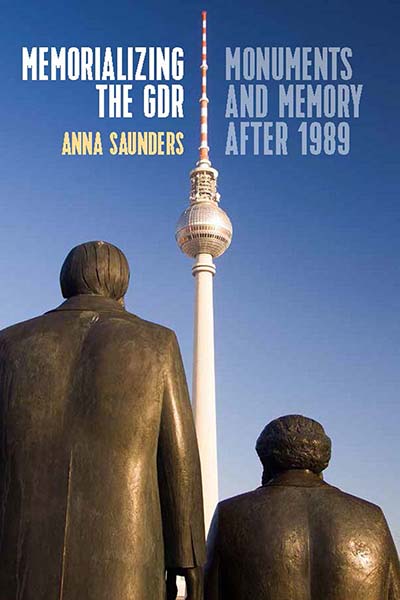We’re delighted to offer a selection of latest releases from our core subjects of Anthropology, Economic History, Film Studies and History, along with our New in Paperback titles.
Continue reading “SIMULATED SHELVES: BROWSE September 2018 NEW BOOKS”


Continue reading “SIMULATED SHELVES: BROWSE September 2018 NEW BOOKS”
 We are delighted to inform you that we will be attending the annual German Studies Association conference in Pittsburgh PA, on September 27th-30th, 2018. Please stop by our stand to browse our latest selection of books at discounted prices & pick up some free journal samples.
We are delighted to inform you that we will be attending the annual German Studies Association conference in Pittsburgh PA, on September 27th-30th, 2018. Please stop by our stand to browse our latest selection of books at discounted prices & pick up some free journal samples.
Berghahn Books is very pleased to invite you to a wine reception at the GSA co-hosted with the DEFA Film Library, University of Massachusetts Amherst. Please join us on Friday, September 28th from 5-6pm in the book exhibit area to celebrate the publication of SCREENED ENCOUNTERS: The Leipzig Documentary Film Festival, 1955-1990 by Caroline Moine, the first volume in our new Film and the Global Cold War series.
If you are unable to attend the conference, we would like to provide you with a special discount offer. In celebration of the New Academic Year, receive a 50% discount, until 30th September 2018 on all German Studies titles found on our website. At checkout, simply enter the discount code GSA18.
Browse our new 2018-19 German Studies Catalog online or visit our website for a complete listing of all published and forthcoming titles. Continue reading “Berghahn will be at the German Studies Association 2018 Conference!”

Continue reading “SIMULATED SHELVES: BROWSE August 2018 NEW BOOKS”
On August 13, 1961, Berlin woke up to a shock: the East German Army had begun construction on the infamous Berlin Wall. The Wall was initially constructed in the middle of Berlin, and expanded over the following months. It entirely cut off West Berlin from the surrounding East Germany, prohibiting East Germans to pass into West Germany.
The Eastern Bloc claimed that the wall was erected to protect its population from fascist elements conspiring to prevent the “will of the people” in building a socialist state in East Germany. In practice, the Wall served to prevent the massive emigration and defection that marked East Germany and the communist Eastern Bloc during the post-World War II period. The Berlin Wall came to symbolize the “Iron Curtain” that separated Western Europe and the Eastern Bloc during the Cold War.
Browse Berghahn relevant titles on History of divided Germany:
 MEMORIALIZING THE GDR
MEMORIALIZING THE GDR
Monuments and Memory after 1989
Anna Saunders

Continue reading “SIMULATED SHELVES: BROWSE July 2018 NEW BOOKS”
 by Anna Saunders, author of Memorializing the GDR: Monuments and Memory after 1989.
by Anna Saunders, author of Memorializing the GDR: Monuments and Memory after 1989. Recent years have witnessed fierce debates about the existence of controversial monuments around the world – most notably Confederate monuments and memorials, but also numerous structures built in honour of wealthy benefactors with murky pasts. The outcomes of such debacles have been varied. In the UK, Oriel College, Oxford, has recently stated its intention to keep its statue of Cecil Rhodes, whereas Bristol’s Colston Hall – named after the slave trader Edward Colston – will be renamed when it reopens in 2020. It seems that the future of monuments may be limited. Yet this depends on our understanding of the role of such structures. In this context, it is worth casting an eye towards Germany, a country whose twentieth century history has prompted the destruction – and construction – of monuments and memorials at a pace rivalled by few others. Continue reading “Why monuments still have a future”
 Celebrated on July, 14, Bastille Day is the French national day and one of the most important bank holidays in France. The day commemorates the beginning of the French Revolution with the storming of the Bastille on the 14th July 1789, a medieval fortress and prison which was a symbol of tyrannical Bourbon authority and had held many political dissidents, and symbolizes the end of absolute monarchy and the birth of sovereign Nation.
Celebrated on July, 14, Bastille Day is the French national day and one of the most important bank holidays in France. The day commemorates the beginning of the French Revolution with the storming of the Bastille on the 14th July 1789, a medieval fortress and prison which was a symbol of tyrannical Bourbon authority and had held many political dissidents, and symbolizes the end of absolute monarchy and the birth of sovereign Nation.
The following year, the Fête de la Fédération was held in Paris and across the nation by a populace that largely believed the French Revolution was over. As it turned out, they were mistaken–and by 1791 there was little in the way of national unity to celebrate. The holiday wasn’t picked up again until 1878 when it was a one-time official feast to honor the French Republic, which was followed by an unofficial, popular celebration of the day in 1879, which in turn led to a call to make it an official holiday in 1880 complete with a military parade which has been an annual fixture ever since.

 CHILDREN OF THE CAMP
CHILDREN OF THE CAMP
The Lives of Somali Youth Raised in Kakuma Refugee Camp, Kenya
Catherine-Lune Grayson